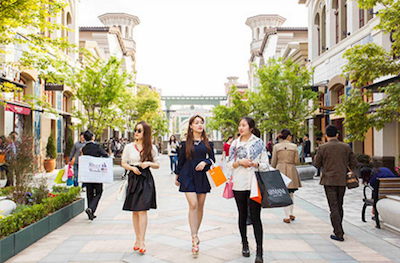China's government efforts as well as the recent weakening of the United States dollar have helped stabilize the yuan in international markets, giving valuable Chinese luxury consumers higher purchasing power.
After losses in 2016, tighter capital controls have helped stabilize China's currency, according to a new report from Toronto Sumitomo Trading International. Stricter control has given investors more confidence, leading to the increased purchasing power, which will be a valuable asset for luxury brands.
"What the [Chinese] government did has worked," said Daniel Holland, director of corporate equities of Toronto Sumitomo Trading International, Toronto, Canada.
"The substantial tightening has stopped the outflows and the foreign investments are coming back in the form of FDIs and bonds," he said.
Fluctuating markets
As markets continue to become more globalized, many luxury brands are beginning to rely on international shoppers.
Of particular interest to luxury brands is the recent growth of wealthy Chinese travelers who represent a significant portion of high-end purchasing.
An overlooked part of international business in luxury is currency rates and the relative purchasing powers of consumers in different countries. In China, the yuan was weakened in 2016, losing around 6.5 percent over the course of the year.

Luxury is one of the biggest industries for ecommerce. Source: L2
But now, thanks to tighter capital controls form the Chinese government, the yuan’s midpoint has been set to 6.8957, 85 pips higher than the previous one at 6.9042.
This means, for luxury brands, that Chinese citizens now have greater purchasing power. Chinese consumers with a higher purchasing power may lead to increases in luxury goods purchases while abroad.
Toronto Sumitomo forecasts that this growth will continue and that the yuan will trade at 6.9 per dollar by the end of 2017.
Stronger capital regulations brought down China’s outbound investments by 35 percent and increased the confidence of investors coming in. These factors all contributed to the Yuan’s stronger showing.
Purchasing power
Chinese travelers represent the largest bloc of luxury consumers in the world, suggesting that high-end brands need to pay more attention to their international customers.
This data comes from Kinetic, which recently analyzed the shopping habits and trends for the luxury market in an attempt to discern the largest demographics in international luxury shopping. The data also showed that luxury shoppers at international airports are ripe for targeting through geofencing technology (see story).
Luxury brands have a vested interest in the fluctuations of currency in the Chinese market.
Chinese luxury goods have also increased in price, as citizens have grown more affluent.

Luxury brands can target valuable affluent Chinese travelers
From June 2015 to June 2016, the luxury consumer price index increased by 5.1 percent, much higher than the standard consumer price index (CPI)’s 1.9 percent increase, per the National Bureau of Statistics of China. As prices increase, China’s upper classes are also growing in number and all consumers are maintaining confidence in the country’s economy, all good signs for brands (see story).
Another reason for the strong showing of the yuan is the relative weakening of the US dollar amid international concerns about war and tensions on the global stage.
"Concerns over the bitter relationship between the U.S. and North Korea and the developing war in Syria weighed on the U.S. dollar and U.S. Treasuries,"said Michael Hudson, head of mergers and acquisitions at Toronto Sumitomo Trading International.
"While it lowered the expectations for a U.S. interest rates hike, very little has changed in Asia's trading session," he said.
{"ct":"kS6uQgiPYADXk9znZLO8xnulb7xSb\/G+wcvFCAvBNi1Mv8Nr8xhf19JHHIttmxNfe\/8lIoEjsPoqgm4w9djQQdIjFALxpI10X7jrkfRemP591MzT\/Mpv6J+Hsaq9+bO3pihqRhjtLOGrUxSibOb8oDwyxoehctOwdA8K\/5TrOAXq0l+1QCORibLfZjMSI0AvVXHBDeS0TkybBrFL88uXE9AeA8B0nvWcL9M2p+5alP921Tg7tvDQmgCsHHkNeHdE43Z6laQllUzBaBN+9yj8YBXrynhKP3Gy+yqRXQLs1f1O0c43Bm14NcmNodQ0cxRjG\/w9NiGzAXq5\/HF0eP5CoD3KiRZa6z1V51e2oZ+kg5u2QcFY2eTrBt\/zr0hOjXL\/FCFTMqw6fkPHrfChCTZ8xsLqi7PnnpC3t8zmLFGN8NsfvuOFplYKMIQsuOcPA31bs1nN9n+hD+Lr7DG+mqReaBTQgm0dQR2jbmhFN2Gowb9hIDWuxpaIDZO2J2QZ5vSTv21ahbkfTE88OwRXPg2rluGYDNOU7+AtH3dzlsppNcIsUWvJHgoq3xyvN0\/tmx5goFTqDQkWBcbYpoEFKuVTuGjrJOAdy6cUpTIzk35GZXADnetkNoJ4X5Mmy5RTMl9pmnzYDmOFA0JEB7qZ2pMuC9uAmNREXrx+wmxjlJPNKg1kuwxnOMJyTKHb4WbCS4qPy90qo78IbtpHUmyJURFA7hwEX80WsWQqd8t\/+NvCMFl2o2\/KZCAHr2kfcau+GLqlXsSfWZ0ntbZ9ejWm1B3MGt0koLTSioEmxWeXma+ZyoEfnA1jDMl\/TL\/5yxBdduWPbrvq\/e86h0WpsQyZf\/XaREAC4FbfZlkAeCzm1UdPpLfbFdurb4OlGOUjUXyNW3GiiotPyXElh4XHRlqnHdDjv+BCqULlBGG4DITpUEHZ5DvlY5RFEuoJkco24xY3iTcA\/H4Ndhczh6lPU1ARJV442MdV1ASqQh+xDHAS9NzykOT0gsv2Mw7U8kRv8Ljfx0y2NjBIHrmk2WQDOvxAq7O37D3vZagep1x6fD5ebgc+J6jUbwxulp\/cm\/xdBcyQz1HPrwO8TPfrpbscy\/JdDfLfrxG09TYb0W+ahG1aGpIJeElcHTfBS41LBb1WNsaqm2ln+hsgfWVFuVL2WkkJoWGAByD9+nftmGC62uEM1x7mkmEk5EZRVP43+uQ66zSCxzNE+HUGrl+uM5UuzWSpFd\/7pehosxeqvdggDUtNj866AmQ\/b0rWf6uhHqOvDLDohaHtZXWtk4holyIEjnyTAMUiAYMTU7OOpAGYHuHfxkqfXivr6a11oQ\/nIk+SFC8Of5LC\/U1FHcHgs0h4hp8F9h2biaRJo9FWHQpNelPviTuq99EBv4pDWU6XONRce2ZPY8HkDy11tQE2txbR6jiTgV95g+ml\/GI9LlnCfVsRDKVqkD06FtRtdiAAj7dqU3GygDuPO87tQK2yw1j4LltVZE5GxELHYi\/euyBfdfzk8mrzwxOk2d\/a1\/glsl\/nTxrODW69RrgAKa1txNKuHUkOZbr+WdvRaI+GRgnZ+PuXMbvY4aNXCqM+WUTlu3olcx0ipjbZkGVd18\/tR6fVQKFKdYPT3m+wA\/X4RZtMdF9dm6reJogIJ2MUH+kOpIxlQwX8A\/Sx4fV\/jlW0nG8eAX8ez1huk0XCLUusULd7OYydXvuVO9paa6ilK73BRI9F+\/NS2vqYSdUTsTmLCePEYv7xqXiPI+Ha9MBvdToaVZwnFH4tTbPgt5S6eY2z7t3GTLof+\/qz0DUgxugIkC4bWfY7JSIh6kQ1GkHEyOzpXxGlLDwxK3VZ5sP9sCarVP5gvi5Ko8UqNaUi1c\/LKq8uNXV5Lc92d+fbofhe977MHyBJXZe+2efC8L7zzW2ACu0TuP2bUu1bUKHBM4Z+pjlvoO01Zrqx5Z\/ktzutYzfhs1ER56MWMm9lZo0KsNOPr\/xL+fp8D98gFp\/2b3LZzvwJVyhuZbbTkIZHzUvUm0z3APKgDBer87i2A+UCC4WkDGzgCR\/g5vcTAoWElFIJ2rLgYp8qK1z1KtdoHPgbppgU\/qzeyWELr20Qr4Vv+P4DITqMsw2FiREyF+UzsOsGff07AdPLgcAIHG4jj255dRNJwcEApX09j9HeQxxXu8irqEUWqVATysgUH\/sUdufsZMxtBDraUMdTXCWWKbbVa5tb7Pc0u+KFWOb+b117fChN0gHzTTB30P2fW8pwLvpb2L81Ony4Kd90+cxoXSEd5xH9dBHE+wj+CxEgUq7GSIOqPn086HDmyD5BNbKg7VL0nq0WZiA8yaiuwiIzqj++mTog2bQ7lMqwPeI137UJ+6YgXFNveNtzGqoTaIaAJgv9h5mw1THuZImO9f+5yv3yrhbXvFMsIZZN1eM5ydSmatn4DkVru9Bg23RH98AKc9k\/pJ7IVHPgpiX84i9RJSV0ys677odtKZzzgGwP7wM4WN8BezQl2Y997IUUckXFbCydSPwXDMc3w4wWx+FW2stW\/szXjBAHvZJPXRLhCQI5qoxuhBTnbqL7rXqJVIoXUle7fCwI3+lDnOIH33tUSlldqQzIeK8RNFOj8Ez7ipRGLzuAG4q3392ca4jHhAF2UaZpPGN9U89NEbiemyTLPZJI8PCKgiHNuxRpozdGYqt\/nQZuuDah5C2JbNyoHQYZl0V9UwuRCYw3GqjHku1uIsLgJfNbtWVo7vMBtU1KO13LtDELAU13Y7iEwOUX2aORpK8Unor\/9Y7KUCNWe76kU5cVF+Vtu0gS2oM0K0G9uTxG6mPHvJIup1nxJAkPXd1FsxgZq75NTRKSpWfuOMUf17AItQkXLBzh3dc5CPGqzL1ffso4FztlNuSbCknnYk8OLDJvi5poHLJ3vKumoVP\/z1oFgUG4pH6lguUkmJDDVTrGXAPNGinEdaCk48aRh6YRyMWCklN6RlWw\/CCuLudOqTy\/mU32NqMWUQgIAWKMgQVdRnIdGbKFwHlGLfKPb8aeYgcTt35dyOUp3MW\/KLypUVJzz3\/wJkwtyq6uBsM2hVjkJtTsSSS3oQwun75tVkTCJC124iiJl63DItqwuF03jpV7iKJ4OHGkWlkLinLn+bieG1+JXx6JdVaA4\/Yf3yWWjM17g5\/OFvAVXr1oHBOXLd+vgnINOvQ\/6FaGgYdkc7St\/8q5Pkp5Nq9Nn7wluxdYqJbG9ZS2vbQu+mO99LwuO3wwzmg0F2MhIl4TSfOqDKs3tzPPTWvCXCjtdxW\/uHFLYlW+4gFhWDWY\/RVKqhFi3OvbNSD5zGaWc8OESpr3VsxP5te5zywwC1ikBrdrrVF4LKmo\/KnlcvwMr\/CimBOy3kTSj6riXCqms3c\/1+FB2StQ1k5BZqM8Jadzs835SMU7WcOt4fOyo2nbcChTnD48YY04JyDIWxTKnTRS0qEsmYz\/qPvcbEAnOFLUC4Z80Bq+sUwLAhx\/Ryk49j3Ny33bzWgAaZlJ\/kH\/1Ai41phtHrm9opl6+32TgP1Qstz6D8y2X9uMrFBCo91uTLtmvWYy4LpkehtNfq8EESgPgcybmTD6UhZhmyqVdx4JkMM+IMUPfLvwS9m6o1\/9cAr3yurcyUIiTkh4LlmDs7zpswaCWP7pj58JYGvTFyYhh7cZlJEZhkYwJU1vHJToksLXVKoSPiX3DKNdbomAoJGKZtiH\/kJwCQcUmM8tm+rcWJ+kPGky4BQ2Zeza0t5SpUQVr5OhMcLJSqy6N6mm37JZ388v\/BHl7LQG6MSpISAKMsUIlQI\/wWWsRAcvHVJ30l84GXpE6XUlncB02zadp6Keb\/aNA1kNvEEXyUHtN7lwp\/a7IqwiXKXsPrcjp3nN8bcMCCpsXRMnJaHu+OEcQgEDvvmghED8yEGEYnVh2n3XWuoFIcr53tec+ZbLo0ijgA7i+pyeHVlpQE\/ZMqszGZN+0lFJ+gpYAjpW+JkxgzQHlBKmBGA1NkFeBWZlWlEyf\/M462IEk5wxBtnlN1mC3phEWMRIgb9WAm0WO+v1wIBBBgKsHJDjSeoxJPnK+7LSErGjDP9bKtnoSmwtU8MfIlDCtaSwG\/1FIl8UU1\/f097ZphBs\/VgE7whXdhw2m10oWH62BJwHfmqRRLCe6QbZhsxNkvfzGpjvixnyoDSMt6tgP+9+E1mN6cVgl+CY+kzV4YD1a5Oy5UQgKtS7+DKhKQOaD1aGAnzWAOm7SZj9CWXy84ex66hZpARfAeyBGPvgTCyit0RWe87rd5wbrZwhjPgO7uJLtK\/rKq+mMI7ShM9Xd90Pj\/7CSxklKplwJxOdcY16p2W3nmUQgDUPqp\/8YwHthEJdOeZYvgBxnWodSd67m2qQiXmnCdV5C6NHe5CCGXUT6XzTK4KZUihPMK9rvig6uLWV5UM8n3lcp8b0NZvixdfFlAxgJlXX67A6PoOHx6BL+gP4kabXjucN2Fc3s51BGi4N1PGm7PyWU0OOgl+bgLVOTwAQOMMn3ZSJuf+VZbWgzH4xvwVvdpDWL460pUsqjncKatQO66bl+ZVjiNoj7idb5t0xiSSwn2j6ySelUXNvZwLiG8hJ0VJSGwPoWzPYf3VqRG477nFO3mWZgCb7qE4dV1isaSm3w45juER19OU4OhriyDtnQfQsFeVYQorVzW4Zfm6Z5lAH56id8E3tMCY0OG5fKi9df1kMHe1s7E23deRBVuPuxi+86lkUOuXAM8pWGgAk5iZmy5HIXbo8UUZ1SoRdNy9zKjkqM3Whp3xFbyvS0kbx51FDVxl6Ded5sGhHvZrYhpzYotUo\/nsXmgFed4EpaV8hmp9hDat\/xt2xe+vXYlJbwGnJjYylD1CpCbVdl0rx+ioWIXOazsfWN5nZCZbwQoE+Oc+kg73JjEBx6bG4wksZRXdZD4DHV+5SYeQNmyqwHdjpEUhhPQuTkQRe2T5b9ZWqYIrU464j+aicxfNS7e\/mJix+aQWPi9Q4wfClQBTtyONwZ14LNqkgSd+l\/wcJp60s\/uBYEsLBHa3GcgQ0JMDg5BJVMHMd9K7AdzJjU33\/pICPSgA6YfeNJMXMETaBIy1Wgv0OCbX99lfBXS3DSVF9blMB4I14EZFQRw5r99+Qzkm9ijfrAYXuE8VNU2uEeaH4x7+gfGd86PWA7uHN3vnNyTZS8XGgEuOpR6qbTfERznUyvCBAwhEkiLKSaU6J2p9brnLE2OLa1y7Sa2Sj0MAxSntnvSX7rcR8Njkne3R6XUG69qjaP\/mA3hTcXCj4xLicVLKue9gMkkOwRqL1IChED9B6Z7d0GzjGVd0Wwdu7+uGmi5rBEga9DXbXM5M3JDsdXFykCxo8kKFkkmVmzD\/JbMX42yR8Q2qzq2nVg6rw3Siq2aeWyQ79Wf2Kda6cieDGL5UXfuZSGJ8XndHgjrkFNICuefoTvfDjfc8Q2RHxUDdI+9iohfnO8A8a41zlJZE9VS\/0QX9MMJngGgz\/UpWJjFEgSWwc34BDYrdFfJ\/QNCXs3d6ZRD+gpAf7t+psm28Gib4iRwogqZTV3c2i5TAKQ6DgQsoTff15hhxBHT7LCrHuH6KBIoR2XPso0a3gd0x0PswcPeoPMNveIEh6CuPKdGrlUNKD9QGBgXjDFzER9lcTDzOxODsIp1Ey2nZSFTm+w2PBJi2tPjNTQuUbT8XwX\/bR3vI55+xyzCaMSbOz7O58Y4LwPXgLZtTpfvIHM8naDm01F30G\/4H4MSKEu0EvPubgkTQffPTHVbILLOQR+M0mSFlvBwWAFb7m0SlJkeKmSI5J\/eOyUe+Yi6nUJeyJM7a+ktLn\/BXgIVzpipg60h\/eN2p5ONkbYumKbaKrYR8B+Myr3B1Hh7lqqiGyaaT2Nx96lAb5Z9C6tlPZ3uxRCNnSf7qZ4+xEksa9FPKViy\/HNgKAc4i3hfQN6WL2HJAM\/whLAnk0bi\/sAdYS3YEwnXnLxVMOBJCI+TdpJDFXK00C+xF\/WkgQxO7vvUbJUBEMk0McHMRz+1mOd+IYjb3\/RWKq5gK0Pmk\/P2SRJikaTXgK+u5\/abxxT5xCVykoVNZ9+cdUyscHVf+qvbX6Oxwhx+oXULB34UkuskFQL42\/fqdGFCmSBLSSRQqRmquwB8ZVlI6S84xYuyBC1JDGOHSdO1xJNOAg1NGICAOFkogWa6BtU77Kl9jqf7BSts99\/kUkO3yY3Fd0vlaaeWx6KD2bzWPGIq9BdG5hmDQvC\/dmut7+XcJch3KSv4S30Q4lq\/PhU8Ie+wltfLk9nj6JB1pMKfvwr+OVlpSA5eFZV\/T4YzRJ6G\/86WDlx7BYHA4n6ZlN8YfxddzF53X+vReUJ26NHo9zgYvrO7AwzXYktq4yybSCSpYQiC6HYeitXUn3r8iUS18cNvp\/PRF3CnfUTOKemKc9P54h9ol+0MNSwoIOpRJmEvJpXKXj0AGr7uxohusLOzjriuypP0xPP7EX6AOnEtmh5emtPU0DVV3J5MY4jOCdlCBYs3o4jiuAkkUxmREAgnEQwqhanWz4+TvEibGjTaG\/P3jODPt62jqjVn+KBnt17sd6qz1EX1idNsOahoieQab8HfihMHgFWY5hdwPtM8S6qFR\/Cis5m5ZyhQzwpHdUzBijGE6MjYVoT1Ha+Kz6\/zckR8XXRdZMa7rTGKfqRZ\/W86QQEBgBVheNaPbgPyDkriCECvADwv5eQtrQ4GI3JZmNCQY2DxUDCW9i6TvZxkVnxwvJ9l8vg1Y0kTwJfk5RrHP6PM10cJGc+ldcz7SomBhb3iovnindl+8IksPgFD4V1MR0K5W9t3R9kMr+h00xQQNcDFvnGSDSR1Bln4xrKsOuzLH\/WS2lejf32RXTVxHLaHfe8attebpvLqd00lIKtTQa6Ql1Qqedi92Lyun1L37g7F2J8AUTFQLqLoco1xb1+VWLlcr1daDcUeahbD1kJ+9cG6jAJ\/Dsvw==","iv":"ea0536afcda02db56dbc1375f6a9af03","s":"7ae30c4b4698675e"}

 Image courtesy of Peninsula Hotels & Resorts
Image courtesy of Peninsula Hotels & Resorts